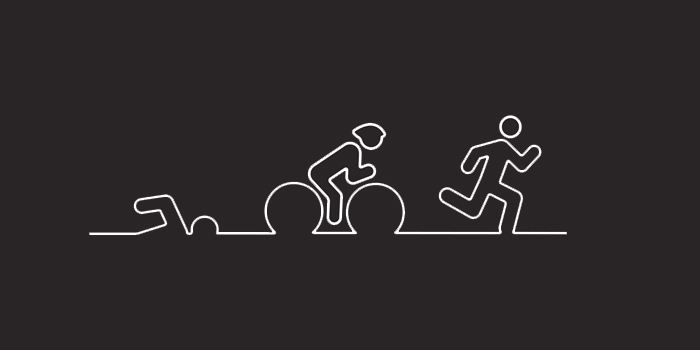
We hear it all the time. Trainers, athletes, and coaches talk about how they would love to increase stamina and get in-shape with cardiovascular endurance and be able to limit fatigue while on the field of play.
Yes, there is a specific and direct way to improve the aerobic capacity system, but many fail to realize that general strength and speed training alone can aid in building better athletes who are less likely to or will take longer to become fatigued.
RECENT: Strength, Velocity, Power — How You Can Build Each to Produce Ballistic Movement
Essentially, if we increase our max speed, strength, and power (maximum output), then the sub-maximal levels we need in the field of play (operational output) are less of a percentage of peak output and are less taxing on our overall energy systems.
I recently had a general population client of mine complete an Ironman competition. This was not his first go-around with an Ironman, so he had prior experience. However, this was the first time he would be competing after several months of strength training. Upon completion of the event, he could immediately tell a difference in his ability to get through the more strenuous portions of the course in terms of muscular fatigue, but he also noticed he had an overall easier time moving through the entirety of the event.
Essentially, strength and speed training positively influenced an event that is very aerobic- and lactic power-based in nature, but why? We must look further and take a better look at energy systems as a whole.
A Brief Look at Energy Systems
As I alluded to, there are multiple energy systems at play that influence the relationship between strength and speed training and things that are more aerobic- or lactic power-based in nature. Let’s take a look at a simple explanation of some of the energy systems at work here.
ostill © 123rf.com
Anaerobic
This energy system is responsible for short bursts of strength and power at maximum output — that is, exertions of our max energy for no more than 12 to 15 seconds.
Put simply enough, this type of activity does not involve the transportation of oxygen throughout the body and is not directly related to what is perceived as the body’s cardiovascular system. Instead, the muscles and production of Creatine Phosphate (CP) and ATP fuel this activity.
There are limited amounts of CP and ATP present in the muscles and they take full recovery to replenish, which is a marked example of anaerobic activity, which tends to have short bouts with full recovery.
Examples:
- Short sprints
- Jumping
- Any type of sport specific activity at max intensity for a short time period
Aerobic
This system is the exact opposite of the anaerobic system, as it directly involves the presence and transfer of oxygen through the body.
TRY THIS: Start Building Aerobic Capacity for Your Sport
This is an activity that is less intense in nature and can be fueled by oxygen. This is opposite of anaerobic activity that is more intense, and without the presence of oxygen, it depends more on the muscles (remember: CP and ATP) as a source of energy.
There are three areas of aerobic activity:
- Aerobic Recovery: very low intensity (roughly 65 percent of max capacity)
- Aerobic Maintenance: designed to maintain the level of aerobic conditioning (roughly 75 to 85 percent of max capacity).
- Aerobic Capacity: designed to improve the level of aerobic conditioning (90 percent or higher)
Lactic Threshold/Power
Quite simply, the lactic threshold/lactic power is a state in which the body has exerted too high of a level of max output for too long of a time where oxygen cannot transport fast enough to support the activity OR the stores of CP and ATP in the muscles has been depleted and was not given sufficient time to restore.
Lactic power is the ability to exert as close to your maximum output as possible while in this state of depleted CP or ATP or when oxygen cannot transport efficiently to support the activity.
Putting The Energy Systems Together
So you are probably thinking to yourself right now, “Well, this is great and all, but what the hell does all this mean?” To tie up the loose ends here, let us again look at maximum and operational outputs.
Maximum Output
The max speed, strength, or power the body is capable of producing at a given time in the most perfect and ideal environment.

ostill © 123rf.com
Operational Output
Either the max output the body can display in non-ideal environments or a sub-maximal output displayed when the maximal output is not needed or necessary.
First and foremost, when we train strength and speed, we are improving our overall strength and speed, a.k.a., our maximum output. If our maximum output is increased, the operational output (i.e., coasting speed in a long distance run or activity of that nature) is a lesser percentage of our maximum output. So, performing our operational output has now become less taxing on our energy systems!
READ MORE: GPP Training: You're Doing It Wrong
Essentially, we have now given our bodies the ability to perform more activity through the anaerobic and aerobic systems because what used to be our maximum output has now become operational and a speed in which we can coast at. Thus, we have limited potential of activity leaving the anaerobic or aerobic energy systems.
Think about it: Your old max-effort sprint no longer fully depletes your CP and ATP because it is no longer your max, and long distance runs are less of a percentage of your max output and therefore takes longer amounts of time to move from aerobic activity to lactic power activity.
What did we learn here? There is most definitely a relationship between your strength and speed training and your energy system effectiveness. By simply getting stronger or more explosive, you are putting fewer demands on your anaerobic and aerobic systems when you perform an activity as operational or sub-maximal output.
Think about this the next time a coach, trainer, or athlete tells you they must perform endless mile runs to get in shape.
Header image courtesy of Jenny Lipets © 123rf.com
Gerry DeFilippo is the owner and founder of Challenger Strength in Wayne, New Jersey. He is also a strength coach for the USPHL New Jersey Hitmen, a strength and speed specialist, and a certified physical preparation specialist certified by Joe DeFranco and Jim Smith. He works with multi-level athletes in a variety of sports helping enhance on-field performance and injury preventions via strength, speed, and mobilization-based programming. Stop by one of his two locations in Wayne, New Jersey.










